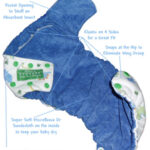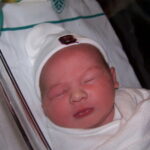Congratulations on your newborn baby! Newborns have simple needs: love, mother’s milk and clean diapers. For the first few weeks of life bowel movements can be very exciting both for baby and parents. Breastfed babies have very different pooping patterns from formula fed babies. Here’s a quick primer on bowel movements in the breastfed baby for those first few weeks and months of newborn life.
Passing Meconium: The First Three Days
The first few bowel movements your breastfed baby will pass are going to be dark and tarry. This is meconium, the normal contents of a newborn’s digestive tract. Meconium is black, dark green or brown and incredibly sticky. Fortunately, colostrum, the early breastmilk, has a laxative effect and will encourage your newborn to pass the meconium. Your infant may poop up to six times that first day.
As your milk supply comes in, the baby’s poop will gradually change color from black to dark green. Then the stools become a lighter, grassy green and finally bright yellow. Breastfed newborn bowel movements are grainy, and often compared to Dijon mustard or cottage cheese in consistency. The smell may remind you of sour milk, yogurt, or even butter. Breast milk is extremely digestible, and stool quantity may be smaller than you expect, no more than a tablespoon at a time.
Finding a Pattern: The First Six Weeks
After the milk supply has settled in and a breastfeeding relationship has been established, your breastfed newborn will develop his or her own pattern of frequency. According to La Leche League, newborns will pass about five bowel movements per day! These poops will continue to be bright yellow in color, seedy, and extremely soft. Occasionally a bowel movement may be greenish tinged. This may be a reaction to something in the mother’s diet, passed through the breast milk. It also may be related to a lack of nutrient-rich hindmilk associated with short feedings. Consult your pediatrician if green poops in your breastfed baby are recurrent.
Mature Breast Milk: From Eight Weeks On
As typical with most things newborn-related, once a pattern is established, it changes a few weeks later. With an older breastfed infant, the nutrient composition of the milk changes to meet the needs of the baby. This will cause a normal decrease in the number of stools passed per day, from five per day down to just one or two per day. The stools will continue to be soft, seedy, and yellow in color. As the baby’s digestive tract matures, it is not unusual for exclusively breastfed babies over two months of age to go a day without passing any stool. This pattern will continue until solid foods are introduced, usually at six months of age or when baby shows developmental readiness.
Denise Bastien, “The Importance of Newborn Stool Counts”, La Leche League
Susan Condon, ‘What’s the Normal Color of a Breastfed Baby’s Bowel Movement?”, Babycenter.com




